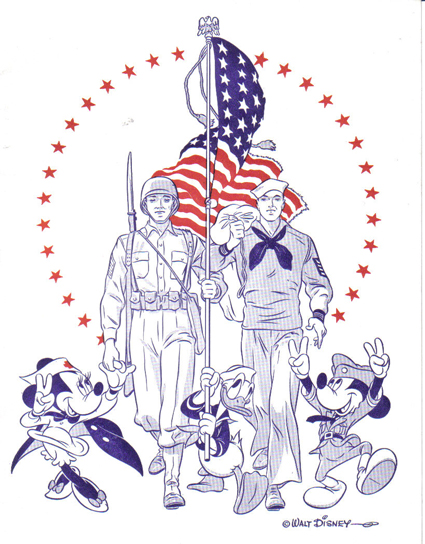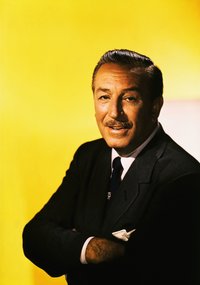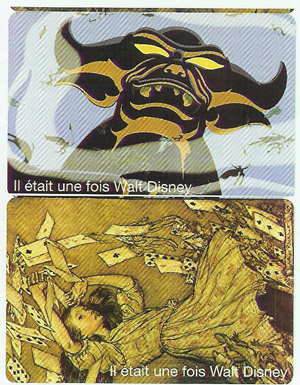
"What's New" Archives: October-December 2006
December 30, 2006:
BUYER'S GUIDE: It's a little late for Christmas shopping, but I'm just now catching up with a variety of books, DVDs, and CDs that I had to set aside while I finished The Animated Man and then fought my way through the holidays. A first recommendation:
 Tom
& Jerry & Tex Avery Too! Volume 1: The 1950s. This
two-CD set, made up of 25 MGM cartoon scores composed and conducted
by Scott Bradley, was co-produced by the cartoon-music expert Daniel
Goldmark, and it shows. The set is a model of how such things should
be done, as much as if not more so than the two CDs devoted to Carl
Stalling's scores for the Warner cartoons. The Bradley scores sound
just great; eight are even in stereo. The new CDs are a vast improvement
over a 1992 CD on the Milan label of six soundtracks from Avery's
cartoons.
Tom
& Jerry & Tex Avery Too! Volume 1: The 1950s. This
two-CD set, made up of 25 MGM cartoon scores composed and conducted
by Scott Bradley, was co-produced by the cartoon-music expert Daniel
Goldmark, and it shows. The set is a model of how such things should
be done, as much as if not more so than the two CDs devoted to Carl
Stalling's scores for the Warner cartoons. The Bradley scores sound
just great; eight are even in stereo. The new CDs are a vast improvement
over a 1992 CD on the Milan label of six soundtracks from Avery's
cartoons.
The cartoons represented in the new set are, for the most part, second- or third-string entries from the 1950s, but as Goldmark explains in the CD booklet, the earlier cartoons' scores were recorded on optical film, rather than magnetic tape, and transferring them to "modern media" would be "an expensive proposition." The new set, like some other CDs issued under Film Score Monthly's banner, is a limited edition (only 3,000 copies), so it's difficult to imagine that sales could ever justify those expensive transfers; but we can hope.
As for the music itself, Goldmark's commentary in the beautifully produced 24-page booklet (for which I provided some photos of Bradley, Hanna, and Barbera) makes as strong a case for Bradley as you'll find anywhere other than Goldmark's landmark book on cartoon music, Tunes for 'Toons: Music and the Hollywood Cartoon. His detailed notes for each cartoon identify Bradley's sources (fewer pop songs and other such borrowings than in Stalling's scores) and the musical devices he used to mimick the animated action.
Bradley is, I have no doubt, a more formally interesting composer than Stalling, particularly in the largely dialogue-free Tom and Jerrys; as Goldmark notes, "these scores seem through-composed, even when maneuvering between an up-tempo band number and a furious chase cue." There are echoes in Bradley's music, too, of the most serious and forbidding sort of twentieth-century concert-hall music. But is Bradley preferable to Stalling, his only real peer among the composers of short cartoon scores? Not for me; Stalling's scores are always completely in the service of what's on the screen, but I find such modesty lacking in Bradley. Even at their best, his scores are a little arrogant; they compete with what's on the screen.
Bradley's ambitions as a serious composer were the cause. He wanted audiences to listen to his music for its own sake, whether he was writing an oratorio or the score for Busy Buddies. If Stalling, the former accompanist for silent films, cherished similar ambitions, they were much more muted than Bradley's. Which means, of course, that whatever their relative virtues as cartoon music, Bradley's scores invite listening on their own, apart from the cartoons. There's no better way to listen to those scores—and form your own opinions about them—than through these two new CDs.
December 27, 2006:
GABLER, CONT'D: I've added another correction for Neal Gabler's Walt Disney: The Triumph of the American Imagination, this one for pages 166-67. This correction is particularly revealing, I think, of one way in which Gabler's "meticulous research" fell short of being truly meticulous.
The more time I spend with Gabler's unfortunate book, the stranger it seems that the Walt Disney Company has embraced it so enthusiastically, to the point that Gabler held a triumphant signing at the studio itself (you can be sure there will be no similar occasion when The Animated Man is published). Disney executives like Roy Disney and Howard Green—I think of them as Gabler's Enablers—gave him their blessing years ago; his book's shortcomings obviously count for nothing when measured against the fact of that official endorsement. Poor Richard Hubler, whose authorized biography was suppressed by Walt Disney Productions at the insistence of the Disney family almost forty years ago, could only have wished for similar indulgence.
December 25, 2006:
A CHRISTMAS THOUGHT: The image above, from 1943, is not Christmas-themed, obviously, but it seems like an appropriate choice for this day, when so many Americans in uniform are observing the holiday so far from home. It comes to you courtesy of Jerry Beck, co-proprietor of the indispensable Cartoon Brew, and Rick Greene, the owner of the booklet of which this is the cover. Rick Greene explains (as relayed by Jerry):
"This is the cover of the dinner program from August 14, 1943
for an event put on by The Masquers and hosted by Cary Grant. In
fact, I own Cary Grant's copy of this program. He asked Walt Disney
to supply the art for the program cover and this is what they came
up with. The dinner,
held at the Hollywood Masquers Club, included performaces by June
Havoc, Robert Armstrong (King Kong) in 'A Chinese Fantasy' and Victor
Borge with Edgar Bergen and Charlie McCarthy in 'The Army's Mess.'The
inside is filled with little Disney drawings of Mickey at the piano,
Pegleg Pete, Jiminy Cricket, one of the Dumbo crows and one of the
Three Little Pigs."
December 24, 2006:
"ANIMATIONS": Michael Sporn wrote in response to yesterday's post from Keith Scott, remarking on the use of that term in Neal Gabler's Disney biography:
"The letter from Keith Scott reminded me that when I did animation for Woman of the Year on Broadway they gave me the credit: 'animations by Michael Sporn.' This appeared in the program on posters and even in the newspapers. I chalked it up to a production office that didn't know better. But then when I did animation for another show on Broadway, "Meet Me In St. Louis," they gave me exactly the same credit! Both of these credits remain on www.theaterdb.com It's odd. Another wing of the Entertainment Business, and they don't get it right."
December 23, 2006:
GABLER: This from Keith Scott, the Australian expert on cartoon voices (and expert voice himself) in regard to my review of Neal Gabler's Walt Disney: The Triumph of the American Imagination:
"I enjoyed the piece on Gabler's book, which, for all its length, I still found surprisingly empty.
"In your list of corrections you mention (with regard
to page 235) his usage of the word 'animations'—that kept niggling
at me throughout his tome from the moment I began reading it. I
immediately thought of late 1960s Britain and Terry Gilliam's contributions
to the TV series Monty Python's Flying Circus. In various
articles about the Python team, as well as in the credits
of the TV episodes themselves,'animations by' was used to describe
the linking by Gilliam of one sketch to another by means of imaginative
(ostensibly 'free-associative') cut-out animation. I don't know
if it is a term used in Europe or maybe just Britain; but certainly
I recall older British film weeklies and annuals of the 1930s and
'40s simply using the word 'cartoons.' It seems a useful term to
describe a one-person job like Gilliam's work, but not the products
of a studio like Disney's. I guess it just feels very strange to
me for an American author to apply the word to American theatrical
animation (shorts and features), when the films have always been
known as cartoons or, generically, simply animation.
"Again I can't escape my feeling that Gabler has no real passion
for cartoons (the kind of passion apparent in that small army of
specialist animation historians/writers/researchers like yourself,
myself, Mark Kausler, Jerry Beck and so on), and while I don't deny
his talent as a writer, he finally seems an odd choice to be ballyhooed
as the biographer of someone whose products should really be the
original spark for his burning curiosity and interest. I certainly
don't feel it."
I agree with Keith, but I think Gabler's book suffers from more than the biographer's lack of "burning curiosity and interest" in Walt Disney.
There are basically two kinds of serious biographies being published today, I think. Some—the dominant breed—are written from the outside, as it were; the author feels no special interest in his subject but makes up for it by gathering and validating an enormous number of facts, which he presents in what is usually a very long book. In biographies of a second kind, the organizing force is less the accumulation of facts than what I've called imaginative sympathy. The biographer tries to see the world as much as possible through his subject's eyes; when he's successful, the subject of the biography comes to life on the page more vividly than ever happens in books of the first kind. It's the rare book (some of David McCullough's may qualify) that combines the best characteristics of both kinds of biography.
The root problem with Gabler's book is that it offers itself as a biography of the first kind but really isn't one; the necessary rigor in the selection and presentation of facts is lacking. Since I published my initial list of Gabler's errors, I've found another sizable error, or rather a set of interlocking errors that span two pages in the book. I'll write about those errors next week. I'm sure there are more waiting to be discovered.
December 22, 2006:
COMPARED TO WHAT?: Amid Amidi of the indispensable Cartoon Brew was too polite to say so, but I rather put my foot in it yesterday when I wondered aloud if any other "golden age" veterans of "comparable stature" to Ollie Johnston and the late Joe Barbera were still with us. Amid offered this impressive list: Bill Littlejohn, Bill Melendez, Bill Justice, Jack Zander, Art Stevens, Rudy Larriva, Bob McIntosh, X. Atencio, Ty Wong, Paul Sommer, Willie Pyle, and Gus Arriola. And as Milt Gray noted yesterday, Bob Givens is alive and well. This is one of those times when comparisons truly are invidious. We're just lucky they're all still here.
December 21, 2006:
JOE BARBERA: John Canemaker has a nice, low-key tribute to Barbera, who died this week at the age of 95, on the back page of this morning's Wall Street Journal. It's available online only to paid subscribers. No startling new information here, although I must admit I was intrigued to learn that "my younger brother and I insisted on eating our Swanson's TV Dinners off trays in front of the Motorola, so we wouldn't miss H-B's Ruff and Reddy, Huckleberry Hound, Yogi Bear and Boo Boo, Pixie and Dixie, Snagglepuss, Augie Doggy and Doggie Daddy, and later the Flintstones and the Jetsons, among other favorite characters."
Canemaker also remarks on the advanced ages at which a number of animation people, like Joe Grant and Chuck Jones, have recently died. Ollie Johnston is still with us, fortunately, but are there any others of comparable stature from the "golden age" who are still alive? I can't think of any.
[UPDATE: Milt Gray writes: "You asked on your website if there are any other people still alive from the Golden Age, and a couple days ago Mark Kirkland told me that at a coffee shop he had just run into Bob Givens, who looks quite well both physically and mentally."]
The author's note for the Canemaker piece says that his Academy Award-winning animated short, The Moon and the Son, is now available through iTunes. That's good news, since I still haven't managed to see it.
December 19, 2006:
 BACK
TO LIFE: The University of California Press sent The Animated
Man: A Life of Walt Disney to the printer this week. I'm still
catching up with a lot of things that got neglected while I worked
on that book, this Web site among them, but I expect to be posting
much more frequently in the coming weeks than I have for the last
few months.
BACK
TO LIFE: The University of California Press sent The Animated
Man: A Life of Walt Disney to the printer this week. I'm still
catching up with a lot of things that got neglected while I worked
on that book, this Web site among them, but I expect to be posting
much more frequently in the coming weeks than I have for the last
few months.
I've just posted a review of Neal Gabler's book Walt Disney: The Triumph of the American Imagination, and there's a link on that page to a long list of the errors and ambiguities I found in Gabler's book. I've also tried to give you some idea of how my own forthcoming Disney biography differs from Gabler's effort.
I have another substantial Disney-related piece in the works, on the current Paris show, and after that I'll be writing a lot more on non-Disney subjects, I sincerely hope.
November 25, 2006:
WALT'S DOWN: Amazon.com, which initially listed The Animated Man: A Life of Walt Disney, my forthcoming Disney biography, at its full list price of $29.95, is now offering it at the pre-publication price of $19.77. Publication is still slated for April.
ANIMATED ACTING: Some months back, I devoted a number of posts to animated acting, and specifically to what I believe is the importance of casting by character. Some of my correspondents seemed to have trouble understanding what I was talking about; Mark Mayerson, uniquely among those who wrote, not only understood but took issue with my ideas. Mark has now expanded his thoughts considerably, and you can read them (and responses from his visitors) on his excellent blog. I'll be responding here myself as soon as I finally put The Animated Man to bed. I envy those bloggers, like Amid Amidi and Jerry Beck of the indispensable Cartoon Brew, who can post good stuff daily even as they turn out one impressive book after another. Not me; I'm older than those guys, and I need more sleep, I guess.
November 9, 2006:
WALT'S UP: You can now pre-order my next book, The Animated Man: A Life of Walt Disney, from amazon.com by clicking on this link. I've been correcting page proofs, the major reason I've not posted anything for a while.
I've also been reading Neal Gabler's Disney biography, Walt Disney: The Triumph of the American Imagination. I'll post a review of some kind in the next few weeks. I'm going to tread carefully because few things are more annoying to me, as an author, than a review by someone whose message to the reader, explicit or not, is this: "If only this poor benighted scribbler had assumed his proper role as my research assistant, and then written the book according to my instructions, it would be so much better." Hollywood Cartoons was the target of a few reviews of that kind from self-proclaimed animation "experts," and I don't want to fall into that trap. Gabler's book and mine are very different, however, and it could be useful for potential buyers/readers to know where I think those differences lie. Anyone seriously interested in Walt Disney is probably going to want to own both books.
October 23, 2006:
 WALT'S
CHURCH: I was in Chicago early last week, and the highlight was
my visit to the Hermosa section of northwest Chicago, where Walt
Disney was born and spent the first four and a half years of his
life. The house where he was born, on North Tripp Avenue, is still
there, as is the church building, two blocks away on Keeler Avenue,
that once housed Saint Paul Congregational. Walt's father, Elias,
built that church, and Walt was baptized there.
WALT'S
CHURCH: I was in Chicago early last week, and the highlight was
my visit to the Hermosa section of northwest Chicago, where Walt
Disney was born and spent the first four and a half years of his
life. The house where he was born, on North Tripp Avenue, is still
there, as is the church building, two blocks away on Keeler Avenue,
that once housed Saint Paul Congregational. Walt's father, Elias,
built that church, and Walt was baptized there.
(Although Saint Paul Congregational has ceased to exist, its records have survived, and they confirm Walt's birth date of December 5, 1901, as well as the date of his baptism.)
 The
former Saint Paul Congregational now houses a Baptist church that
serves a neighborhood that has become heavily Hispanic. The neighborhood,
made up of small, neat homes, and quiet, tree-shaded streets, must
look very different from the Hermosa of the 1890s, when Elias Disney
was building frame houses in what was then a raw new development
on mostly treeless prairie; but the church building appears remarkably
little changed. Craig Pfannkuche, the Chicago researcher who accompanied
me, thought that even its windows were original. We visited just
before the Sunday morning service, and the members of the very small
congregation were warm and welcoming—as, I imagine, the members
of Saint Paul Congregational were, when visitors showed up a hundred
years ago. Today's churchgoers were pleased to learn of their church's
connection with Walt Disney (if, that is, they had any idea who
Walt was; many of them didn't).
The
former Saint Paul Congregational now houses a Baptist church that
serves a neighborhood that has become heavily Hispanic. The neighborhood,
made up of small, neat homes, and quiet, tree-shaded streets, must
look very different from the Hermosa of the 1890s, when Elias Disney
was building frame houses in what was then a raw new development
on mostly treeless prairie; but the church building appears remarkably
little changed. Craig Pfannkuche, the Chicago researcher who accompanied
me, thought that even its windows were original. We visited just
before the Sunday morning service, and the members of the very small
congregation were warm and welcoming—as, I imagine, the members
of Saint Paul Congregational were, when visitors showed up a hundred
years ago. Today's churchgoers were pleased to learn of their church's
connection with Walt Disney (if, that is, they had any idea who
Walt was; many of them didn't).
 My
visit to the church was a surprisingly moving experience. I had
never before felt so fully aware of Elias Disney, a good man who
has gotten a bad rap from most of his biographers (but who was well
loved by Walt and Roy Disney). I found it very easy to imagine him
in the pulpit of that little church, filling in for its English-born
pastor, the Reverend Walter Parr.
My
visit to the church was a surprisingly moving experience. I had
never before felt so fully aware of Elias Disney, a good man who
has gotten a bad rap from most of his biographers (but who was well
loved by Walt and Roy Disney). I found it very easy to imagine him
in the pulpit of that little church, filling in for its English-born
pastor, the Reverend Walter Parr.
Saint Paul was as much of a church home as Walt Disney ever had. He never attended religious services in his adult years, even though in 1960 he accepted the honorary chairmanship of National Sunday School Week. "Religion exercises a powerful influence on a person's whole life," Walt said in accepting the appointment. "In the formative slate of a boy's or girl's life, religion can be the balancing power of future happiness, and there is no better place for the furtherance of belief than in Sunday school." Elias's shade no doubt snorted when he heard that.
CARTOON MODERN: Gene Schiller writes about my review of Amid Amidi's major new book: "You describe John Wilson’s striking conceptual art for Petroushka as misshapen, and by inference, unworthy of inclusion in Amidi’s Cartoon Modern. Let’s chalk that up to a matter of taste. Nonetheless, it’s impossible to judge animation on the basis of a few freeze frames, and the animation in this Petroushka is actually quite good—fluid, beautifully stylized, and in perfect synchronization with Stravinsky’s music. The production, it should be noted, was the winner of numerous international awards, and bears the imprimatur of Stravinsky himself—a notoriously tough customer, whom as you know, did not care all that much for Fantasia."
MB replies: As far as I know, Wilson's Petroushka isn't available commercially, and that's a pity; I'd like to see it. I'm certainly open to the idea that questionable character designs might prove themselves in animation, but I don't think it happens very often.
FUNNY ANIMALS: Thanks to my travels, I haven't gotten around to seeing Open Season yet, and I may not have time to see it before it leaves town. A pity, since I'm struck by the novelty of its premise: wisecracking animals turn the tables on human hunters. If the boys at Warner Bros. had only come up with some idea that clever back in 1940, they might have made a success out of Bunky Bunny, or whatever that silly hare's name was.
If you're interested in funny animals who do more amusing things than the ones in Open Season appear to do, you could pay a visit to Paul Etcheverry's Web site and read what he has to say about Walter Lantz and Bill Nolan's The Hash Shop, among other pre-Code cartoons. There's a bear in The Hash Shop who shoves a full-size horse down a rabbit's throat, so that the rabbit's body stretches to assume the shape of the horse's. If anything half as intriguing happens in Open Season, I sure haven't heard about it.
October 13, 2006:
 WALT
ON THE WALL: I was in Europe for the last three weeks, part of that
time in Paris, where I paid two extended visits to the huge new
Disney exhibit, "Il Était Une Fois ... Walt Disney"
("Once Upon a Time ... Walt Disney") at the Grand Palais.
(The tickets are rather neat; my two are at the right.) The exhibit
will be up in Paris until January 15 and then in Montreal, at the
Musée des Beaux-Arts, from March 8 to June 24.
WALT
ON THE WALL: I was in Europe for the last three weeks, part of that
time in Paris, where I paid two extended visits to the huge new
Disney exhibit, "Il Était Une Fois ... Walt Disney"
("Once Upon a Time ... Walt Disney") at the Grand Palais.
(The tickets are rather neat; my two are at the right.) The exhibit
will be up in Paris until January 15 and then in Montreal, at the
Musée des Beaux-Arts, from March 8 to June 24.
Has the exhibit, which presumes to identify the sources that inspired the Disney artists, been conceived and presented in a way that will make it of lasting importance, through its encouragement of fertile new thought about the Disney films? Of course not; this is an officially sanctioned Disney project, after all. But should someone seriously interested in Disney history try to get to Paris or Montreal and see the exhibit's hundreds of pieces of original artwork and its other fascinating relics? Of course.
I'll offer some extended comments in a few weeks, after I receive the catalog from Amazon's French branch (it was too big to fit into my luggage) and I've disposed of the page proofs for The Animated Man: A Life of Walt Disney. In the meantime, you can visit the English-language site for the Paris exhibit by clicking here.
WALT IN PRINT: Speaking of The Animated Man, the University of California Press has posted a page about the book here. The page is still a tad preliminary-looking at this point; it's in the nature of such pages that they change and improve as publication approaches. Unlike the UC page, Amazon.com's page for the book still includes no price or ordering information, but presumably such details will be forthcoming.
FUNNIES: The New York Times reviews "Masters of American Comics" today and likes that two-part exhibit better than I did when I saw it in Los Angeles earlier this year. Michael Kimmelman's review makes me glad, though, that I saw it in L.A. rather than New York, since the exhibit's installation, at the Newark and Jewish museums, evidently leaves a lot to be desired. (Art Spiegeleman pulled his work from the show in protest.) I'm going to have to take another look at Gary Panter, I guess; I've never been attracted to his comics, but they get a lot of praise from people who seem to know what they're talking about.
To read my own review of "Masters," click here.
CHICAGO: I'll be there this weekend, tagging along on one of Phyllis's business trips and tying up loose ends by visiting a few Disney sites I'd missed. Back next week.